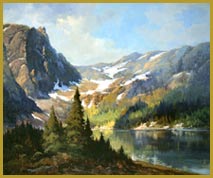|
Robert Wood in the Pacific Northwest
by Jeffrey Morseburg
Robert Wood lived in the Northwest from about 1918 to 1924, when he moved south to Texas. In these early years he primarily did smaller works, usually in elongated rectangular formats such as 8" x 16", 12" x 24" or 18" x 36". These small, inexpensive "buckeyes" were often painted in his workshops in Seattle, then Portland, where his Japanese assistants helped lay the initial composition in. The early works (before 1925) were done in a hurried, more primitive style because he was still years from reaching artistic maturity and the market for fine paintings was not very developed in the Pacific Northwest.
Many early Robert Woods were not signed on the front and bore a rubber stamp impression – "Robert Wood Studio" or "Robert Wood, Artist" – on the back. These works were usually painted on inexpensive art board, so their survival rate is low. Larger works could be on canvas. Wood has been said to have used a pseudonym, "B. Redman," in the Northwest and so we have on occasion attributed works with this signature that are consistent with his stlye to him. Early Northwest works have a minimal commercial value because theyfall far short of the quality of his mature paintings.
The Cascades are one of America's great mountain chains. Stretching
from Mt. Lassen and Mt. Shasta in the South to British Columbia,
the range extends more than seven hundred miles. Most of the summts,
many of which reach an excess of 10,000 feet, are extinct volcanos.
Robert
Wood painted in the Cascade range before 1920, when he spent an
extended time in Washington and Oregon. Mt. Hood was a popular subject
for him, and a number of works by him of Mt. St. Helens, which erupted
in 1980, have been discovered. Wood
did many paintings of Mt. Shasta from the 1920s until the 1960s.
Paintings have also been cataloged of Mt. Lassen and the famous
Oregon peaks called the Three Sisters.
Copyright
2003 Jeffrey Morseburg. Not to be reproduced without specific written
permission. |



